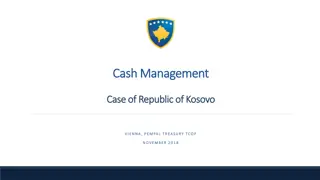Understanding the Importance of Cash Flow in Business
Explore the significance of cash flow in business operations, distinguishing between cash and profit, managing cash carefully for sustainability, and interpreting cash flow forecasts. Learn why cash is essential for paying suppliers, avoiding business failure, and supporting overall financial stability.
Download Presentation

Please find below an Image/Link to download the presentation.
The content on the website is provided AS IS for your information and personal use only. It may not be sold, licensed, or shared on other websites without obtaining consent from the author. Download presentation by click this link. If you encounter any issues during the download, it is possible that the publisher has removed the file from their server.
E N D
Presentation Transcript
PowerPoint Guide The news icon is hyperlinked to a related article or website. Simply click to access The film icon is hyperlinked to a related clip. Simply click to access The discuss icon indicates suggested points to discuss The calculation icon indicates a calculation task
3.6 Finance 3.6.2 Cash flow
Key elements to this topic The importance of cash to a business Cash versus profit Calculation and interpretation of cash flow forecasts
Why is cash important to a business? Cash is the lifeblood of a business If a business runs out of cash it will almost certainly fail Few businesses have access to unlimited finance cash is restricted, so it needs to be managed carefully
Why is cash important? To pay suppliers, overheads and employees
Why is cash important? To prevent business failure
Cash versus profit Profit is recorded when a sale is made, whereas cash is recorded when it is received. This means that a business selling on credit can be making a profit despite having no cash. Profit is affected only by running costs, whereas cash is affected by start up, running and expansion costs. This means that when a business buys fixed assets (items of value which are held in the business for over a year) cash is affected, but profit isn t.
What is cash flow? Cash flow is the process of cash flowing in and out of a business i.e. cash inflows and outflows
Net cash flow Net cash flow is the difference between cash inflows and cash outflows over a trading period
Cupcake cash flow The Cupcake Cavern is a small bakery and caf specialising in cupcakes and pastries. On the following slide, identify its cash inflows (money flowing into the business) and cash outflows (money flowing out of the business).
Main types of cash inflow and cash outflow Cash inflows Cash sales Cash outflows Payment of overheads, wages and salaries Receipts from trade customers Payment of suppliers, for example raw materials, inventories Sale of spare assets Buying equipment Investment of share capital Interest on bank loan/overdraft Personal funds invested Payment of dividends Receipt of bank loan Repayment of loans Government grants Income tax, VAT and corporation tax
Why is it important to forecast cash flow? Cash is the lifeblood of a business. If a business runs out of cash it will be unable to pay suppliers, overheads and employees and may become insolvent, leading to business failure.
A cash flow forecast A cash flow forecast is a table showing predicted opening balances, cash inflows, cash outflows, net cash flows and closing balances over a trading period.
Opening and closing balances The opening balance is the value of cash at the start of a trading period. The closing balance is the value of cash at the end of a trading period.
Cash flow forecast - illustrated Forecast is normally produced by month Jan Feb Mar Total CASH INFLOWS Investment Sales 10,000 2,500 10,000 27,500 Net cash flow is the difference each month between total cash inflows and total cash outflows 10,000 15,000 Total inflows 12,500 10,000 15,000 37,500 CASH OUTFLOWS Raw materials Wages & salaries Marketing Set-up costs Other costs 4,000 3,500 2,500 3,000 2,000 5,000 4,000 1,000 1,000 1,000 5,000 4,000 2,000 14,000 11,500 5,500 4,000 4,000 Opening balance is the amount the business starts with each month 0 1,000 Closing balance = opening balance + net cash flow. A negative closing balance (deficit) suggests the business needs a bank overdraft, additional finance, analyse inflows and outflows to ensure it can continue to trade Total outflows 15,000 12,000 12,000 39,000 NET CASH FLOW -2,500 -2,000 3,000 -1,500 Opening balance Closing balance 0 -2,500 -4,500 -4,500 -1,500 -2,500
Cash flow formulae Net cash flow = total cash inflows total cash outflows in a given period Opening balance = closing balance of the previous period Closing balance = opening balance + net cash flow
Cash-flow forecast - fill in the gaps Jan Feb Mar Total Comment on the cash flow forecast that you have constructed, using as many key terms linked to cash flow as you can. CASH INFLOWS Investment Sales 15,000 5,000 10,000 15,000 Total inflows CASH OUTFLOWS Raw materials Wages & salaries Marketing Set-up costs 5,000 10,000 2,500 5,000 5,000 4,000 1,000 1,000 5,000 4,000 2,000 Examples include: Cash inflows Cash outflows Net cash flow Closing balance Surplus Deficit 0 Total outflows NET CASH FLOW Opening balance Closing balance
Cash-flow forecast - fill in the gaps Jan Feb Mar Total The closing balance in January and February shows that the business is expected to have a negative cash flow or deficit of 3,500 in February. CASH INFLOWS Investment Sales 15,000 5,000 15,000 30,000 10,000 15,000 Total inflows 20,000 10,000 15,000 45,000 This is due to the cash outflows being higher than the cash inflows in the first two months and the opening balance is predicted to be 0. CASH OUTFLOWS Raw materials Wages & salaries Marketing Set-up costs 5,000 10,000 2,500 5,000 5,000 4,000 1,000 1,000 5,000 4,000 2,000 15,000 18,000 5,500 6,000 This means that the business may find it difficult to cover day-to-day expenses during this period and may need to arrange an overdraft. 0 Total outflows 22,500 11,000 11,000 44,500 NET CASH FLOW -2,500 -1,000 4,000 500 In contrast, March sees the business enter a positive closing balance or surplus, as the business is predicted to no longer need to pay for set-up costs. Opening balance Closing balance 0 -2,500 -3,500 -3,500 500 -2,500
Common problems with cash flow forecasts Sales prove lower than expected Easy to be over-optimistic about sales potential Market research may have gaps Customers do not pay up on time A notorious problem especially for small businesses The cost of production proves higher than expected Perhaps because purchase prices turn out higher Could also be due to the business operating inefficiently Certain costs are not included A common problem for a start-up Unexpected costs always arise often significant
Just a minute Suggest three ways Guide Bridge could improve its cash flow
Possible solutions to cash flow problems (1) Possible method Pro Con A flexible form of finance Access to extra finance is immediate, if the overdraft has been arranged previously with the bank Interest is only paid when the overdraft is used Interest charges can be high The business may have difficulty negotiating an overdraft, particularly a new start-up The bank can withdraw the overdraft facility at any time Overdraft Asking customers to pay more quickly/reducing their trade credit period will speed up inflows into the business Negotiating a trade credit period, or a longer trade credit with suppliers, will enable a business to sell its products before it has to pay for them, improving its cash flow Customers may be unhappy to pay earlier and may switch to rival businesses; a discount for early payment may need to be offered to customers as an incentive Some businesses, for example start-ups, may find it difficult to negotiate trade credit with its suppliers The business may not be able to sell its stock, but will still need to pay for it when payment is due Re-scheduling payments
Possible solutions to cash flow problems (2) Possible method Pros Cons By reviewing its outflows, a business can reduce its costs, such as stock purchases, wages; this could result in the business being more efficient Negotiating better deals with suppliers can be time consuming Cheaper stock may result in lower quality products being produced, damaging customer relations in the long term Cutting back on wages e.g. offering overtime to staff, may result in reduced staff motivation and labour productivity Reducing cash outflows Additional revenue can be raised if new methods of generating cash can be successfully found Changing the price can increase demand and revenue Additional promotional activity can increase awareness and demand Finding new methods of generating cash inflows can be time consuming Additional promotional activity may result in additional cash inflows, but the business should ensure that the costs of this activity are covered Increasing cash inflows Sale of shares would provide a permanent injection of cash into the business A bank loan would provide a lump sum of cash Sale of assets would provide a lump sum that would not need repaying Sale of shares dilutes the ownership of the business and is time consuming A bank loan would need repaying with interest; it would take time to arrange The asset would no longer be available; the amount received will usually be lower than the amount paid Finding new sources of finance
Reasons why a cash flow forecast is important Identifies potential shortfalls in cash balances in advance Ensures the business can afford to pay suppliers and employees Helps to spot problems with customer payments Important part of financial planning External stakeholders, such as banks, may require a regular forecast
Concept links Can you link these concepts in context of a small business? Insolvency Survival Planning Sentence starter - One benefit to a small business of producing a cash flow forecast is Cash flow forecasting
Concept links Sentence starter - One benefit to a small business of producing a cash flow forecast is Insolvency Survival This will mean they can identify shortfalls in cash and take action to prevent insolvency, for example it can take out a loan or arrange an overdraft early on. As a result, the business can be confident in being able to cover cash outflows and thus survive. Planning Helps in the planning of cash inflows, such as sales. Cash flow forecasting























